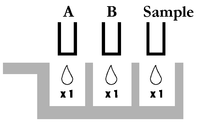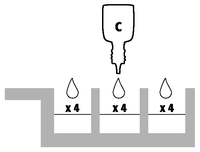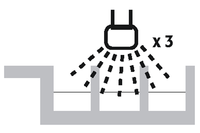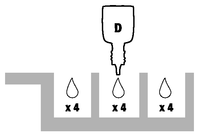Ovucheck Premate 5 and 10 (Canada)
This treatment applies to the following species:Kit for Determination of the Level of Serum or Plasma Progesterone in the Bitch
Insert
2013-06-05
OVUCHECK® PREMATE is a semi-quantitative test for the measurement of progesterone in a drop of plasma or serum of the bitch. The quantity of progesterone present is indicated by a change in colour, which is compared with high and low progesterone standards.
This kit is quick and simple to use. It gives reliable information which allows you to:
- plan mating at the optimum time
- determine the time of whelping
- investigate the causes of infertility (anovular cycles, silent heats with normal ovulation
Physiological Basis
Hormonal changes occurring in the bitch in the course of pro-oestrus, oestrus, beginning of dioestrus, and gestation are described below.
At the end of pro-oestrus, the drop in oestrogen levels, secreted by the maturing ovarian follicle, causes the luteinising hormone (LH) surge. Ovulation normally happens 24 to 48 hours after the LH surge.
The follicle gradually produces progesterone above basal levels (<0.5 ng/mL) a few days before the LH surge. When the LH surge occurs, progesterone levels may reach 2 to 4 ng/mL.
At the time of ovulation, the progesterone level is generally between 4 and 10 ng/mL. This normally happens 11 to 13 days after the start of pro-oestrus (characterized by the presence of blood and swelling of the vulva).
After ovulation, progesterone levels continue to rise to reach maximal levels 2 to 3 weeks after the start of dioestrus. However, there are large variations between breeds and individuals. The determination of progesterone level with OVUCHECK® PREMATE in association with other elements such as the behaviour of the dog and vaginal cytology allows determination of the time of ovulation and therefore the optimal time for mating.
At the end of gestation, 12 to 24 hours before giving birth, the level of progesterone falls again to reach values of less than 2 ng/mL. Thus, a level of progesterone higher than the low standard of the OVUCHECK® PREMATE test shows that parturition will not occur in the next 12 to 24 hours.
Sampling
Timing of sampling:
In order to determine the time of ovulation, the first samples are taken and tested after the appearance of signs which mark the start of oestrus (slight losses of blood, acceptance of the male, or characteristic vaginal smear), approximately 6 to 9 days after the start of pro-oestrus.
In the case of a bitch which has a known history of failed conception, or if you suspect that ovulation is early, it is preferable to start the tests from pro-oestrus in order to establish basal progesterone levels for further comparison.
Collection of samples:
Serum: Collect a sample of blood in a dry tube (no serum separator tube) in the usual manner (1 mL of blood is enough). Allow to coagulate (for about half an hour at ambient temperature) and use the serum on top to perform the test.
Plasma: Collect a blood sample in a heparin-coated tube and separate the plasma from the red blood cells by centrifugation, then use the plasma to perform the test.
Operating Procedure
Bring all the components to room temperature before use (about 30 minutes). Make sure every solution is properly mixed before use.
Substrate preparation:

- Carefully remove the screw cap from bottle D. Then, take out and discard the stopper.
- Without touching it, eject the substrate tablet into bottle D by pressing the back of the metal foil (be careful no to touch the tablet with your fingers).
- Place the supplied nozzle into bottle D. Put on the cap and screw firmly to ensure the nozzle fits securely into the neck of the bottle.
- Mix at regular intervals, until the tablet has completely dissolved (15 to 30 minutes). The solution may now be yellow, orange or pink.
Storage of the substrate:
- Write the date on the label. The mixture prepared in bottle D is now stable for up to three months if kept refrigerated (2 - 7°C).
- This solution can be frozen for a longer period of conservation. The expiration date is then shown on the outside label on the kit box. You can aliquot solution D, to avoid repeated freeze/thaw cycles. For example, you can use insulin syringes (0.6 mL per syringe). This way, you will only have to take one syringe out of the freezer each time you perform the test.
- The colour of the solution of bottle D (when activated) can change with time but this does not affect results interpretation.
Carrying out the test:
Two standards are provided (A and B). They must both be used each time an assay is performed to validate the test.
1. Take out a strip of wells from the plastic bag.
2. Select the necessary number of wells (2 + n, n being the number of samples to test) by breaking the plastic between the wells. Put the unused wells back in the plastic bag. Mark for identification purposes the top of the first well you will use.
3. Always use a new pipette for each sample or standard. Keeping the pipette vertical, add:
- 1 drop of low standard (A) to the first well.
- 1 drop of high standard (B) to the second well.
- 1 drop of the sample to be tested to the third well.
Each sample to be tested shall be added to a different well. Wells must either contain a standard or a sample, not both.
If the pipette is not held in a vertical position, the drop volume could be smaller and affect the accuracy of the test.

4. Keeping bottle C vertical, add 4 drops of reagent C to each well.

5. Cover the wells with a sheet of opaque paper and incubate for 15 minutes at room temperature.
Be careful not to reverse the bottles caps of the conjugate (C) and the substrate (D).
6. Empty the contents of the wells into the sink and gently rinse the wells three times, using lukewarm tap water. Dry by tapping onto absorbent paper. To allow better colour differentiation, avoid overdrying.

7. Keeping bottle D (or insulin syringe) vertical, add 4 drops of the prepared substrate to each well.

8. Cover the wells with a sheet of opaque paper to protect them from light and incubate for 15 minutes at room temperature.
9. Agitate the wells gently to mix the contents and compare the colour of the sample to the colours of the high and low standards.
- To help visualise the results, place the wells on top of a white background and look at the wells from the top.
- It is important to first check that standard A (low progesterone) is of a darker pink than standard B (high progesterone).
Ovucheck Premate 5 and 10 Indications |
 |
 |
 |
 |
 |
|
|
The sample is darker than A (low standard). The progesterone concentration is lower than the low standard (3 ng/mL). |
The sample is the same shade of pink than A (low standard). The progesterone concentration is about 3 ng/mL. |
The sample is lighter than A, but darker than B. The progesterone concentration is between 3 and 10 ng/mL. |
The sample is the same colour as B (high standard). The progesterone is concentration is about 10 ng/mL. |
The sample is lighter than B (high standard). The progesterone concentration is higher than 10 ng/mL. |
|
HEAT DETECTION |
The bitch is in the pro-oestrus phase. Test again in 2 days. |
The bitch is in the pro-oestrus phase. Test again in 2 days. |
Ovulation is imminent. Test again the next day. |
Ovulation has probably taken place. A period of 2 to 3 days is then necessary for the ovum to mature. Because of the relatively long survival of spermatozoa in the genital tract of the bitch, you can mate the bitch in the next 24 to 48 hours. |
Ovulation has probably taken place. Proceed to mating without any further delay. |
|
TERM DETECTION 1 |
The bitch is probably due to whelp. Whelping should take place within 12 to 24 hours. |
Whelping will probably not take place in the next 24 hours. Test again the next day. |
The bitch is not due to whelp. Whelping will probably not take place before 48 hours. Test again in two days. |
||
|
PROLONGED ANOESTRUS |
The bitch is not secreting progesterone. There are two possibilities: she has not ovulated or she has not been in heat for the past 2 months. |
The bitch is secreting progesterone. Heat has probably occurred unnoticed or the bitch suffers from an ovarian pathology. Test again in one month in order to document the duration of the rise in progesterone. |
|||
1 The progesterone concentration by itself does not determine the exact time of onset of parturition. This value must be interpreted in light of other criteria for estimating the time of parturition.
Precautions
- Keep the kit refrigerated (2-7°C). DO NOT FREEZE.
- Keep the bottles containing the standards in the upright position so that the liquid does not touch the cap.
- Do not use the kit after the expiration date.
- Do not use wells more than once.
- Do not mix components of a kit (wells and reagents) with those of another kit.
- The solutions in bottles A, B, and C contain a preservative.
- When emptying the contents of the wells into the sink, rinse away with a large amount of tap water.
- If the product splashes into the eyes or onto the skin, wash thoroughly with tap water.
- For in vitro veterinary diagnostic use only.
- Keep out of reach of children.
- Do not pipette solutions by mouth.
OVUCHECK® PREMATE is a semi-quantitative test for the measurement of progesterone. If a quantitative value is required, it is recommended to use the OVUCHECK® PLASMA kit.
For more information, contact technical services at Biovet Inc. (support@biovet-inc.com).
KIT CONTENTS
|
PREMATE 5 |
PREMATE 10 |
|
|
A 1 X 1.0 mL |
A 1 X 1.0 mL |
Ready-to-use |
|
B 1 X 1.0 mL |
B 1 X 1.0 mL |
Ready-to-use |
|
C 1 X 5.0 mL |
C 1 X 8.5 mL |
Ready-to-use Conjugate |
|
D 1 X 8.5 mL |
D 1 X 8.5 mL |
Substrate Buffer |
|
1 tablet |
1 tablet |
Substrate |
|
2 X 8 |
4 X 8 |
Coated Microwells |
|
18 |
35 |
Plastic Pipettes |
|
1 |
1 |
Rubber Bulb or Plastic Pipettes |
1 Keep the bottles containing the standards in the upright position so that the liquid does not touch the cap.
Manufactured by Biovet - Canada, 4375, av. Beaudry, St-Hyacinthe (Québec), J2S 8W2, CANADA
Tel.: 1-888-824-6838, 450 771-7291
Fax: 450 771-2996
Technical services: support@biovet-inc.com
www.biovet.ca
Can. Vet. Biol. Estab. Lic. No. 49
CPN: 36940013
4375 AVENUE BEAUDRY, ST-HYACINTHE, QC, J2S 8W2
| Telephone: | 450-771-7291 | |
| Toll-Free: | 1-888-8BIOVET | |
| Order Desk: | 1-888-824-6838 | |
| Technical Service: | 1-888-824-6838 | |
| Fax: | 450-771-4158 | |
| Website: | www.biovet-inc.com | |
| Email: | support@biovet-inc.com |
 |
THIS SERVICE AND DATA ARE PROVIDED "AS IS". Animalytix assumes no liability, and each user assumes full risk, responsibility, and liability, related to its use of the Animalytix service and data. See the Terms of Use for further details. |

Copyright © 2024 Animalytix LLC. Updated: 2024-02-27
